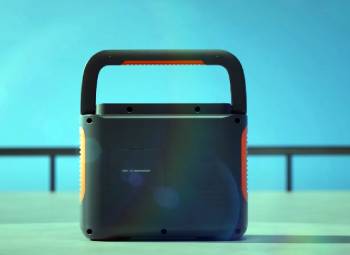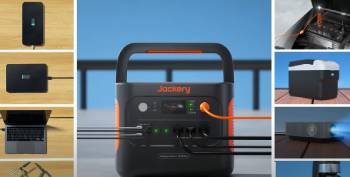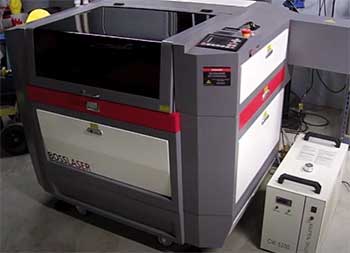I’m no stranger to power outages, camping trips, or the frustration of a dead laptop in the middle of nowhere.
That’s why I’m excited to compare the Jackery Explorer 1000 v2 and 1000 Plus, two portable power stations that promise to keep your devices humming.
My goal is to break down their features, performance, and quirks from a real user’s perspective, helping you decide which one fits your lifestyle.
Whether you’re prepping for emergencies or planning an off-grid adventure, this article will guide you to the right choice.
Comparison Table: Jackery 1000 v2 Vs. 1000 Plus
| Feature | Jackery Explorer 1000 v2 | Jackery Explorer 1000 Plus |
| Battery Capacity | 1070Wh | 1264Wh |
| Battery Type | LiFePO4 | LiFePO4 |
| AC Output | 1500W (3000W surge) | 2000W (4000W surge) |
| Weight | 24.2 lbs (11 kg) | 32 lbs (14.5 kg) |
| Dimensions | 13.3 x 9.2 x 10.6 in | 14 x 10.2 x 11.1 in |
| Charging Time (Wall) | 1.7 hrs (1 hr emergency mode) | 1.7 hrs |
| Solar Input | 400W max (3 hrs with 3x200W panels) | 600W max (2 hrs with 4x200W panels) |
| Expandable | No | Yes, up to 5kWh with battery packs |
| Ports | 3 AC, 2 USB-C, 1 USB-A, 1 DC | 3 AC, 2 USB-C, 2 USB-A, 2 DC |
| App Control | Yes | Yes |
| Warranty | 3+2 years | 3+2 years |
| Price (Approx.) | $800 | $1000 |
My Journey with Portable Power Stations

I’ve always been a bit of a gear nerd, especially when it comes to staying powered up.
Last summer, during a camping trip in the Rockies, my old power bank left my phone dead by day two.
That’s when I started researching portable power stations.
Jackery’s Explorer series caught my eye for its reputation and sleek design.
After testing both the 1000 v2 and 1000 Plus, I’m ready to share what I’ve learned.
These devices aren’t just for campers—they’re lifesavers for power outages, remote work, or even tailgating.
Let’s explore what makes each one tick.
Unboxing and First Impressions
When the Jackery 1000 v2 arrived, I was struck by its compactness.
At 24.2 pounds, it’s light enough to lug to a campsite without breaking a sweat.
The bright orange accents scream “adventure,” and the foldable handle is a game-changer for storage.
I tucked it neatly in my car’s trunk for a weekend trip.
The 1000 Plus, however, felt heftier at 32 pounds.
It’s not back-breaking, but I noticed the extra weight when hauling it upstairs.
Its design is similar, but the slightly larger footprint made me think twice about packing it for short trips.
Both have intuitive LCD screens showing wattage, battery level, and charging status.
I appreciated the clear readouts, even in bright sunlight.
Setting them up was a breeze—just plug in the AC cable, and you’re off.
I charged the 1000 v2 in emergency mode via the Jackery app, hitting 100% in just an hour.
The 1000 Plus took 1.7 hours, which is still impressively fast.
Key Features of the Jackery 1000 v2
The 1000 v2 is a compact powerhouse.
Its 1070Wh LiFePO4 battery offers up to 4,000 charge cycles, meaning it’ll last a decade with regular use.
I powered a 60W mini fridge, a 100W laptop, and a 20W phone charger simultaneously, and it barely flinched.
The 1500W AC output (3000W surge) handled my 800W coffee maker without a hiccup.
I love the versatility of its ports: three AC outlets, two 100W USB-C, one USB-A, and a DC car port.
The ChargeShield 2.0 technology impressed me with its 62 safety protections, including overcharge and temperature control.
I tested the UPS function by plugging in my router during a storm—it switched to battery power in under 20 milliseconds, keeping me online.
Solar charging with two 200W SolarSaga panels took about three hours in full sun, perfect for off-grid adventures.
The app let me toggle between fast, quiet, and energy-saving modes, which I found handy for late-night charging.
At $800, it’s a steal for its portability and power.
Key Features of the Jackery 1000 Plus

The 1000 Plus steps things up.
Its 1264Wh capacity is about 18% more than the v2, and the 2000W AC output (4000W surge) powered my 1200W microwave for short bursts.
I ran a 200W air cooler and a 100W TV for hours, and it still had juice left.
The port selection is slightly better: three AC, two 100W USB-C, two USB-A, and two DC ports.
What sets it apart is expandability—you can add up to three battery packs, boosting capacity to 5kWh.
I haven’t tested this, but it’s ideal for prolonged outages.
Solar charging is faster, with a 600W max input, recharging in two hours with four 200W panels.
The app control is identical, but the 100 Plus feels more suited for heavy-duty needs.
Priced around $1000, it’s a premium option for those needing extra power and flexibility.
Pros and Cons of the Jackery 1000 v2

Pros:
- I’m smitten with the 1000 v2’s portability—it’s a breeze to carry at 24.2 pounds.
- The 1500W output powers most of my camping gear, from coolers to coffee makers.
- Its one-hour emergency charge via the app is a lifesaver when I’m in a rush.
- The LiFePO4 battery’s 4,000-cycle lifespan means I won’t need a replacement for years.
- Quiet operation at under 30dB lets me sleep soundly during overnight charging.
- The UPS function kept my router running during a power flicker—seamless.
- At $800, it’s a budget-friendly powerhouse for short trips or emergencies.
Cons:
- The 400W solar input cap feels limiting compared to the 1000 Plus.
- No expandability means I’m stuck with 1070Wh, which may not cut it for long outages.
- Only one USB-A port feels stingy for charging multiple small devices.
- The lack of a car charging cable in the box annoyed me—$30 extra isn’t cool.
Pros and Cons of the Jackery 1000 Plus
Pros:
- The 1264Wh capacity gives me extra runtime for power-hungry devices.
- Its 2000W output handled my microwave and air cooler like a champ.
- Expandable up to 5kWh, it’s perfect for extended outages or RV living.
- Faster 600W solar input means I’m back to full power in just two hours.
- Extra USB-A and DC ports make it a multi-device charging beast.
- The LiFePO4 battery’s longevity ensures a decade of reliable use.
- App control and UPS functionality add smart, practical touches.
Cons:
- At 32 pounds, it’s noticeably heavier, which I felt on longer hauls.
- The $1000 price tag stings, especially for casual users.
- Solar panels are pricier, and you’ll need more for max charging speed.
- It’s overkill for basic camping if you don’t need the extra capacity.
Real-World Testing: How They Perform

I put both units through their paces during a weekend camping trip and a simulated power outage at home.
For camping, I packed the 1000 v2 because of its lighter weight.
I powered a 60W fridge, a 50W fan, and two 20W phone chargers for 12 hours, using about 70% of the battery.
The quiet operation was a blessing—my campsite stayed peaceful.
Solar charging with a 200W panel worked well, though clouds slowed things down.
At home, I tested the 1000 Plus during a mock outage.
I ran a 150W fridge, a 100W laptop, and a 40W TV for 10 hours, draining 80% of the battery.
The UPS function shone when I “cut” power to my router—no dropped connections.
The 1000 Plus’s extra capacity gave me confidence for longer outages, but I didn’t need the expandability for my needs.
The v2’s portability made it my go-to for travel, while the Plus felt like a home backup beast.
Which One Fits Your Lifestyle?
Choosing between the 1000 v2 and 1000 Plus boils down to your priorities.
If you’re like me, loving quick getaways or needing a lightweight backup, the 1000 v2 is your match.
Its $800 price and 24.2-pound frame make it ideal for camping, tailgating, or short outages.
The one-hour charge is clutch for spontaneous plans.
But if you’re prepping for extended power cuts or running high-wattage appliances, the 1000 Plus is worth the $1000.
Its 1264Wh capacity, 2000W output, and expandability suit RV campers or homeowners in storm-prone areas.
The faster solar charging is a bonus for off-grid enthusiasts.
I found the v2’s simplicity perfect for my weekend adventures, while the Plus’s power gave me peace of mind at home.
Maintenance Tips for Your Jackery Power Station
- Keep It Charged: I charge my Jackery every three months, even when not in use, to prevent battery degradation. A 30-70% charge is ideal for storage.
- Clean Regularly: Dust can clog the vents, so I wipe the exterior with a damp cloth monthly. I avoid harsh chemicals to protect the casing.
- Store Properly: I keep my units in a cool, dry place, away from direct sunlight. Extreme heat or cold can harm the battery.
- Check Cables: I inspect the AC and solar cables for wear before each use. Frayed cables can reduce charging efficiency.
- Update Firmware: The Jackery app occasionally prompts firmware updates, which I install to optimize performance. It’s quick and keeps the unit running smoothly.
Frequently Asked Questions (FAQs)
The 1000 Pro has a 1002Wh Lithium-Ion battery and 1000W output, while the 1000 Plus offers a 1264Wh LiFePO4 battery, 2000W output, and expandability up to 5kWh.
No, the 1000 v2 has a fixed 1070Wh capacity with no option to add battery packs.
It can power appliances up to 1500W, like fridges (150W), laptops (100W), fans (50W), or coffee makers (800W), for hours, depending on wattage.
Yes, if you need portable power for camping or short outages, the 1000 v2’s $800 price and features make it a solid investment.
Final Thoughts
After testing the Jackery 1000 v2 and 1000 Plus, I’m convinced they’re both stellar choices, but your needs will decide the winner.
The 1000 v2’s portability and affordability make it perfect for your weekend escapes or small emergencies.
The 1000 Plus’s extra power and expandability are ideal for bigger setups or long-term backup.
Whichever you pick, you’re getting a reliable, user-friendly power station that’ll keep your devices alive.
Trust me, your next adventure or power outage will feel a lot less stressful with one of these by your side.

